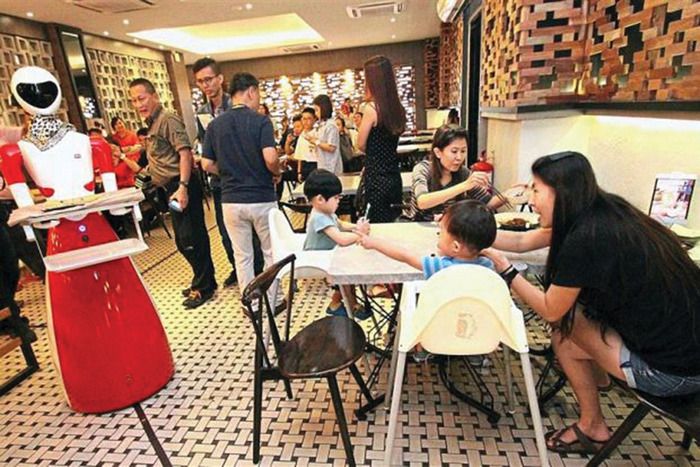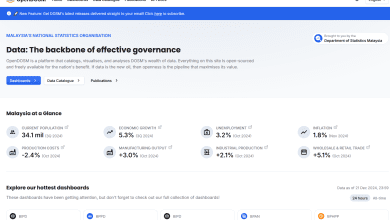Robot Waiters: Gimmick or God-send?


By Mariam Mokhtar
In early January, an article in The Star, about Nam Heong Kopitiam at Ipoh Soho, caused a frisson of excitement amongst Malaysians. The main attraction was not its food, its service, its location, its decor or ambience. People patronised the kopitiam to savour the experience of being served by robots.
Meals on wheels at this kopitiam – Nation | The Star Online
The robots are called “Lui Sun Pong” (Goddess Gang), a term used to describe a group of beautiful celebrities. They were identified by the names, of famous Asian celebrities such as Dilraba Dilmurat, Hannah Quinlivan, Michelle Reis, Fan Bingbing and Angelababy.
The robots move along tracks in the floor of the restaurant, and with the aid of sensors, they are able to detect the presence of obstacles, to prevent collisions.
Jacklyn Lim, the assistant general manager of Nam Heong, stressed that the main function of the robots is to deliver food. On their first day of work, on January 6, she told reporters that the robots, which had been programmed to speak in English and Cantonese, would greet the customers before asking them to collect their food from a tray, held by the robot.
She said, “They could say ‘Welcome’, ‘Your food is served, please enjoy’, ‘I’m in operation, please give orders’ and ‘Excuse me’.”
Lim said that customers had to touch a sensor on the robot’s arm to tell it to return to the waiting area and added that the restaurant chain planned to instal robots at its outlets in Kuala Lumpur and Genting Highlands. The company had invested 30,000 yuan (about RM18,467) in the robots, and said, “We have eight robots here in Ipoh and two more at our outlet in Da Men Mall, in Selangor.”
Denying reports that the robots were an attempt to replace human waiters, Lim stressed that their use would instead help to improve service efficiency. She said that the robots were powered by rechargeable batteries, which could last for eight hours.
Nam Heong employs 25 serving staff to take orders from customers, serve food and clean the restaurant. Lim claimed that the use of robots would reduce the time to serve food to customers, from 15 minutes to about 10 minutes.
She added, “In this era of advanced technology, we hope to incorporate these elements into our services.”
The restaurant’s human resource manager Charmaine Sai thought that some people would take appreciably more time, to adapt to being served by robots and said, “I think the people need to accept that robots will be part of our lives.
“It’s a great way to use machines to assist in our work. It is more efficient.”
Owners of restaurants and other establishments have always tried to make their staff work harder, or for longer periods, within the confines of the laws, which restrict working hours to safe limits.
Increased automation in restaurants will address the shortfall in labour, make certain sections of the operation more efficient, and generate savings in other areas, with the hope of generating more profits for the business.
With the increased use of robots, there will also be calls for staff to be given higher wages. The other risk is that increased automation may generate fears that human staff could be replaced by robots.
One person said, “More employers will appreciate how attractive the use of robots will be for the business. There won’t be employees calling in sick. There will be no need to find staff to replace those who are on leave.
“Just think of the constancy in service by robots in the back rooms, like in food preparation. The addition of ingredients to a dish will be more uniform, and the preparation processes, like chopping and mincing, and where ingredients are added, will be more uniform and not subject to large variations in effort.”
Other people disagree and said, “I will always value human interaction, the smile on the face of the serving staff or the chef, when a meal is enjoyed and appreciated.
“What happens when the order is wrong, or you change your mind, or you would like to make the dish less spicy, or omit certain ingredients because you are allergic to something? In the past, I had problems explaining my preferences to humans. I would have greater problems discussing my specific requirements with a robot.”
The mother of three young children said, “My children would love the idea of being served by robots, and perhaps, they will sit still and finish their food, instead of running around, complaining about something, or gawping at other diners; but I think that the novelty would die off after a few visits.”
A busy executive said, “I spend long hours at work, and I think going out to eat is an experience which should be about comfort, good food, interaction with other humans, including the serving staff. I do not think that going to a restaurant with robot waitresses would appeal to me.”
So, would you like to be served by a robot, or would you insist on human interaction with a warm-blooded waitress?
Have you been served by a robot, either at Nam Heong Kopitiam, or any other restaurant? What is your experience of these machines? Do you think that robots are more efficient and time saving, than humans? Do share your experience with Ipoh Echo readers.


